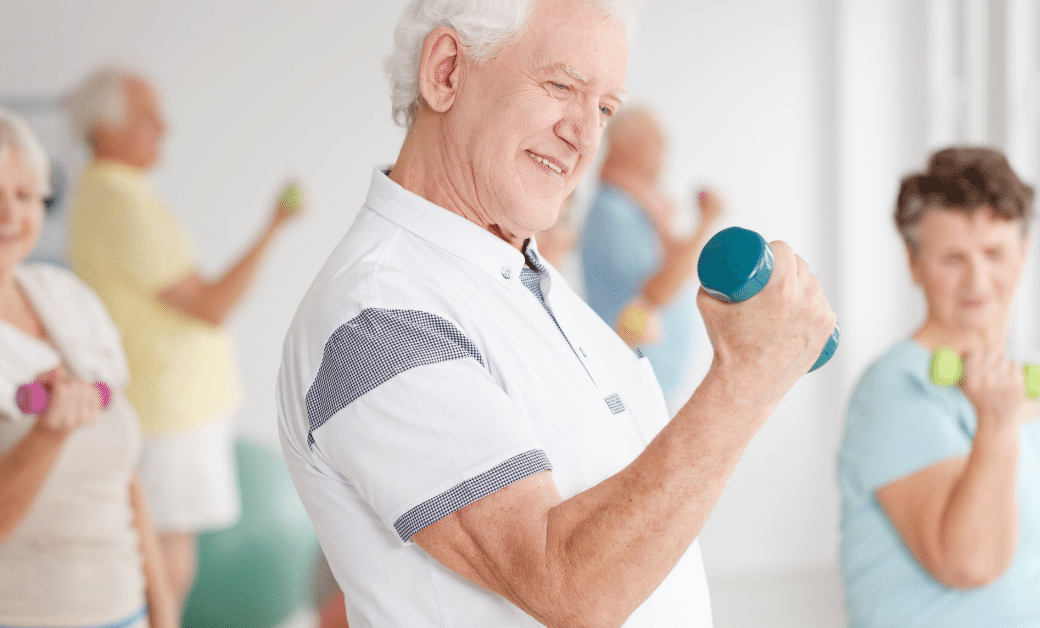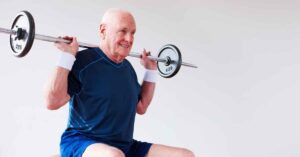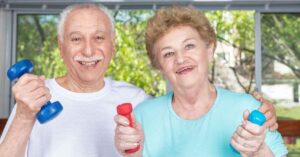Benefits of Physical Exercise for Older Adults
In this article I'm going to discuss the benefits of physical exercise for older adults and the elderly.
Last updated August 2022
Broadly speaking it's probably fair to say that the vast majority of us know that exercise and physical activity are crucially important to better health. What I'm going to discuss in this article are the specific benefits of physical exercise for older adults and why older adults need to pay closer attention to the type of physical activity and exercise they choose to do. I will also shine a light on certain myths and misnomers that are prevalent.
What do we mean by physical activity and exercise?
It's important to define what we actually mean by physical activity and exercise because they are very broad terms and not all exercise is created equally. Some forms of physical activity and exercise effect our health in different ways and so it's important to understand what exercise choice is going to align best with our goals. But make no mistake, the benefits of physical exercise for older adults is very clear across all types.
What do you associate with the term exercise? Running? Walking? Weight lifting? Sports? Yoga?
Well all of those examples are definitely forms of exercise but they will have different effects on our physiology. For example, running and weight lifting will have very a different impact on our bodies. Whilst running is very good for improving cardiovascular fitness and health it's not so good at improving our muscle strength.
Of course weight lifting is the most optimal choice of exercise for improved muscle strength. A lot of different exercise and physical activity choices will have overlapping benefits and often it's a case of choosing an exercise that you enjoy most to try and ensure that you actually do it regularly.
So exercise and physical activity encompasses a very broad range of activities and they are all beneficial to our overall health but specific choices will have a bigger impact on specific goals. I'll talk more about this later in the article.
Why is it important for older adults to exercise?
It's really no secret that exercise and physical activity is a critically important factor for better health across our entire life span. The benefits of physical exercise for older adults and the elderly certainly isn't a well kept secret. It's a fact that's entrenched into society and if I was to ask a sample of people what factors contribute to better health a large proportion of them would have physical activity and exercise high up on their list.
There is a definite increase in the importance for older adults to exercise regularly when compared to their younger counterparts. The benefits of physical exercise for older adults are probably more pronounced when compared to the younger generation. People in their teens, 20 and 30's are less likely to be negatively impacted by lack of exercise in their routine at least in the short term.
How age effects our physiology
As we age, regular exercise becomes a greater priority for better health and the benefits of physical exercise for older adults becomes more pronounced. There are a number of reasons for this:
Metabolic changes
Perhaps the most significant difference between younger and older people is the metabolic changes that occur with age. With age, our bodies just don't generally work to the same levels of efficiency as younger people. Certain internal systems slow down and become less responsive and changes begin to occur that make it harder to do certain activities. A good example of this is the blunted response to protein synthesis in older adults.
Protein is 1 of the 3 critical macronutrients for life, each with a slightly different roles within the body. Protein is responsible for creating and preserving our muscle tissue (among other things). We need to eat a certain amount of protein in order for the stimulus to be great enough to kick start the muscle preserving/building process. In older adults and the elderly, that stimulus is blunted and therefore more protein is needed when compared to younger people.
Loss of muscle mass
As we age we lose muscle much faster and this muscle loss can be further exacerbated by certain age related syndromes such as sarcopenia or osteopenia. Muscle mass actually begins to decline in our 40's but it declines at a much slower rate. That rate of muscle decline increases rapidly in older adults and the elderly. This results weakness and frailty and eventually loss of independence. Preventing frailty and weakness is one of the key benefits of physical exercise for older adults.
Increased risk of chronic diseases
Chronic diseases such as heart disease and diabetes are far more prevalent in older adults and the elderly and this is often because they've had longer exposure to risk factors. Someone who has been overweight for 20 years is far less likely to have developed a weight related chronic disease when compared to someone who been overweight for 50 years. Those metabolic changes I mentioned a second ago also play a role.
Even older adults and the elderly who have generally upheld healthy protocols for most of their life are still at a far higher risk of developing chronic diseases.
All these listed factors can be positively manipulated by implemented certain lifestyle habits, and you guessed it, exercise is near the top of that list.
How does exercise/physical activity help with ageing?
We've discussed why exercise is so important for older adults and the elderly in particular so now let's look at how exercise helps with ageing.
If you've followed me for a any length of time you'll know I talk about resistance training all the the time. And that's because resistance training is of absolute paramount importance for older adults and the elderly. When I talk about the benefits of physical exercise for older adults I like emphasise resistance training.
*quick note - ALL forms of exercise are beneficial but I will be be focusing on resistance training in this section.
Resistance training is simply exercising is such a way that you provide a weighted stimulus to your muscles. That stimulus is needed in order for muscles to grow and become stronger (or at the very least stay the same size and strength).
I've already talked about the increased rate of muscle mass loss being an issue for older adults/elderly and so resistance training becomes of even more importance as we age. We must do something to halt that rapid increase in loss of muscle mass and strength.
By performing resistance based exercise you are providing that crucial stimulus to your muscles in order for them to adapt and grow. Gravity is the constant force we are overcoming at all times but because our bodies are so incredibly adaptable that force that gravity provides just isn't enough after in the long term. And so we have to find ways to increase the resistance we are placing on our muscles.
There are certain everyday activities that help to do this to an extent. Things like carrying shopping bags, lifting pots and pans when we are cooking and doing house chores such as hoovering all help to provide at least some stimulus to our muscles but it's just not enough.
When we also include the fact that technology has made everyday chores so much easier it doesn't help the situation. Even I can remember (I'm 33 years old) pushing around a heavy vacuum cleaner when I was younger. These days vacuum cleaners weigh next to nothing and they are incredibly easy manoeuvre.
Note - Things like vacuuming and other house work are considered to be light forms of exercise.
There are electric chairs that move back and fourth to help us sit and stand. Everyday items such as kitchenware is made from lightweight alloys.
All this technology is both a blessing and a curse. On the one hand it does help those with reduced strength and mobility such as older adults and the elderly but on the other it serves to create the actual problem that it's helpful for in the first place.
Technology isn't doing a great job at actually solving the root cause of the problem. It's just creating hacks and work arounds that are helpful for getting things done but are not helpful at improving the fundamental issues at hand. It's taking away our need to exercise and therefore we're seeing less of the benefits of physical exercise for older adults and the elderly.
The resistance based exercise that is so crucially important needs to be done in a structured and measured way. That way it's possible to track the improvements we are making as we progress.
You can check out one of the Wise Fitness Academy 20 minute resistance based home workouts below
How does an older adult/elderly perform resistance training?
The best way to perform resistance exercise is to lift weights. The issue is, very few older adults or elderly people are lifting weights and resistance training on a regular basis. Weightlifting is generally seen as younger persons activity. Younger people make up the bulk of gym memberships and gyms are typically filled with young people lifting heavy weights. Seldom do you see older adults or elderly people in gyms.
The ironic part of this is, it's the older adult and elderly population who should be in the gym. Far more so than younger people.
Lots of older adults and the elderly feel nervous or intimidated to go to a gym but luckily there are plenty of other ways to perform resistance training. With a bit of knowledge and now how resistance training can be done easily from your home. Obviously this is something that we at Wise Fitness Academy specialise in.
Resistance training doesn't have to be done at a vigorous intensity in order for benefits to occur. Gentle resistance training using a combination of weights and bodyweight will help to preserve or grow and strengthen muscle tissue which will in turn have a huge impact on things like risk of falls, balance, function, chronic conditions and other health problems.
What do we mean by "regular" exercise/physical activity?
It's important to clarify what we mean when we say "regular" exercise. Because how often you do exercise is really important and can determine how successful you are with achieving certain goals.
In terms of resistance training, a regularly applied stimulus is absolutely crucial for growing or even preserving that muscle mass. Doing resistance training a few times per month won't provide you muscles with enough stimulus. It may help prevent the speed of muscle mass decline but it's very unlikely to stop it.
Instead resistance training needs to be performed 2-5 times per week. It does't have to consist of hour long, gruelling sessions. Gentle sessions with adequate rest times and moderate intensity will work well.
A low impact activity such as walking should be done on most days. Walking is a fantastic form of exercise which has numerous health benefits and is often underrated as to just how healthful it really is. One of the great things about walking is that it's very low impact and can be done anywhere.
That means the vast majority of people can do it, even older adults and elderly people who may have certain mobility limitations.
The NHS guidelines on exercise suggests that older adults over 65 do at least 150 minutes of moderate intensity activity a week or 75 minutes of vigorous intensity activity if you are already active, or a combination of both.
Your choice of exercise will change the optimal frequency by which you partake in it but as a general rule at least some form of exercise or physical activity should be part of your everyday life.
What is the best exercise for the elderly?
There are innumerable benefits of physical exercise for older adults and pretty much any exercise type will have positive health impacts. It is often the case that people become fixated on a specific type of exercise that might be "best". This way of thinking is mostly driven by the main stream media and spurious marketing.
The truth is, there is no silver bullet. There is no one exercise that is necessarily any better than another. As I've already discussed there are certainly exercise types that probably rank at a higher importance than others. Resistance training being high up on the list of importance.
For clarity I will breakdown my personal opinion on how to assess what exercise types might be best for for older adults and the elderly.
- The exercise of choice that you will actually do regularly. It's all very well going into detail about why and how certain exercise choices might be best for older adults and the elderly but at the end of the day, will you do it? It's far better to pick the exercise that you enjoy and will actually do than no exercise at all. Having read this article you'll have a better understanding of just how important resistance training is but that knowledge is useless without action and I don't expect for one minute that every reader will start doing resistance training.
- Resistance training. A pretty obvious second place choice given how much I've already discussed it in this article. Muscle mass and strength is just paramount to independence and overall health.
- Cardio/general activity. The third choice pretty much encompasses everything else. Walking, running, sports etc. They are all going to be beneficial for lots of reasons. Whilst there are so many exercise choices for improved cardio fitness and health there just isn't really an alternative to resistance training.
With that said, when I work with clients I always strongly encourage them partake in some resistance training as part of our program. Often, just having some accountability, support and education can help overcome the fears and hesitancy of trying resistance exercise.
For the most part we all do things in life we don't necessarily want to do and sometimes exercise, and more specifically, resistance training is one of those things.
What are the social and psychological benefits of exercise for older adults and the elderly?
Among the benefits of physical exercise for older adults and the elderly are positive social and psychological impacts. It is well documented that exercise has a profound effect on our mood and mental health.
This critical literature review looked at the effects of exercise on a range of mood disorders and found that on the whole exercise had a positive effect. Exercise also positively impacts conditions frequently associated with mood disorders such as anxiety, pain, and insomnia.
This randomised controlled trial studied a sample of 29 subjects aged 60 years and over who were randomised to a 10-week program of supervised exercise or education, and were later followed-up for another 20 weeks. They found a significantly greater decline of depression scores amongst subjects in the exercise group after 20 weeks and 26 months.
The evidence is growing and on the whole shows a positive impact between exercise and mood. Combining what regular exercise does for physical health with what it does for psychological health should make it a no brainer that all older adults and the elderly should participate in it.
Of course the social elements of certain exercise choices are evident. Regular social interaction is strongly associated with better health and so choosing to exercise with friends or family might be an added bonus for you improved health.
The worlds 5 blue zones where life expectancy is significantly higher than anywhere else in the world highlights regular social interaction as one of the common denominators between the zones.
How can physical activity be improved in the elderly?
By now hopefully you have a much better understanding of the benefits of physical exercise for older adults and the elderly and I think that's a big part of the battle. Education is a key element in getting the older generation to exercise on a more regular basis and not only that, but also understanding and choosing certain types of exercise that might benefit them most.
There are benefits of physical exercise for older adults across numerous health parameters that should not be overlooked. Exercise is one of the most significant interventions that can be implemented for better health.
How does the Wise Fitness Academy implement the benefits of physical exercise for older adults and the elderly?
I'll leave you with this video of me having a rant about the social paradigm of older adults and the elderly doing participating in resistance training.








[…] is just about the most important type of training to choose. I touched upon this in my article "benefits of physical exercise for older adults". In this article I'll expand on exactly why strength training for older adults is so […]